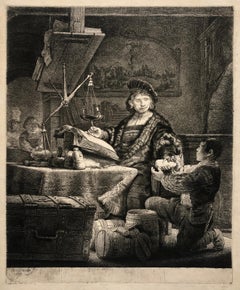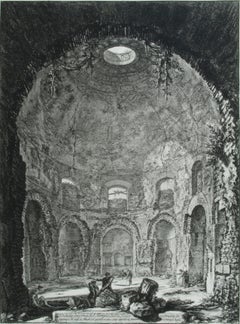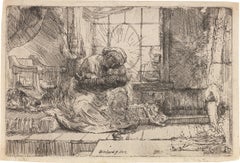Rembrandt van Rijn Interior Prints
Dutch, 1606-1669
Rembrandt was the most influential 17th Century Dutch painter. After years of early success as a portrait painter, his life was beset by financial hardship and personal tragedy. He continued to paint portraits and develop etchings. Rembrandt's portraits of his contemporaries, self-portraits and illustrations of scenes from the Bible are regarded as his greatest creative triumphs. His self-portraits form a unique and intimate autobiography, in which the artist surveyed himself without vanity and with the utmost sincerity. Like many artists of the Dutch Golden Age, such as Jan Vermeer of Delft, Rembrandt was also an avid art collector and dealer. Rembrandt never went abroad, but he was considerably influenced by the work of the Italian masters and Netherlandish artists who had studied in Italy, like Pieter Lastman, the Utrecht Caravaggists, Flemish Baroque, and Peter Paul Rubens. Rembrandt's foremost contribution in the history of printmaking was his transformation of the etching process from a relatively new reproductive technique into a true art form, along with Jacques Callot. His reputation as the greatest etcher in the history of the medium was established in his lifetime and never questioned since. Few of his paintings left the Dutch Republic while he lived, but his prints were circulated throughout Europe, and his wider reputation was initially based on them alone.(Biography provided by Lost Art Gallery)
to
3
2
1
1
2
Overall Height
to
Overall Width
to
3
3
3
2
2
1
3
36
90
86
74
51
2
1
1
Artist: Rembrandt van Rijn
Jews in the Synagogue
By Rembrandt van Rijn
Located in Boston, MA
Bartsch 126; Hind 234; Nowell-Usticke 304 v/VII. Signed and dated in the plate above the shoulder of the second man from the left (obscured by diagonal shading): "Rembrandt f. / 1648...
Category
17th Century Old Masters Rembrandt van Rijn Interior Prints
Materials
Etching
Jan Uytenbogaert, The Goldweigher
By Rembrandt van Rijn
Located in Boston, MA
Bartsch 281, Hind 167 iii/III, Nowell-Usticke 281, iii/III. A fine impression, with burr, as retouched by Baillie in 1792. With an unidentified collectors stamp, verso.
Category
17th Century Old Masters Rembrandt van Rijn Interior Prints
Materials
Drypoint, Etching
The Death of the Virgin
By Rembrandt van Rijn
Located in San Francisco, CA
A strong, dark 18th century impression of Bartsch's third and final state. Similar to that found in an impression of the same state in the collection of the Metropolitan Museum of Ar...
Category
18th Century and Earlier Old Masters Rembrandt van Rijn Interior Prints
Related Items
S. Paolo Fuori Le Mura (Vedute della Basilica di S. Paolo fuor della mura)
By Giovanni Battista Piranesi
Located in Fairlawn, OH
S. Paolo Fuori Le Mura (Vedute della Basilica di S. Paolo fuor della mura)
Etching, 1748
From...
Category
1740s Old Masters Rembrandt van Rijn Interior Prints
Materials
Etching
The So-Called Tempio della Tosse, Near Tivoli. Interior Upright
By Giovanni Battista Piranesi
Located in Fairlawn, OH
The So-Called Tempio della Tosse, Near Tivoli. Interior Upright (Veduta interna del Tempio della Tosse)
"Temple of the Cough"
Etching, 1764
Signed in the plate
From: Vedute di Roma...
Category
1760s Old Masters Rembrandt van Rijn Interior Prints
Materials
Etching
Church of St. Costanza, Rome: An 18th Century Piranesi Architectural Etching
By Giovanni Battista Piranesi
Located in Alamo, CA
This is a framed 18th century Giovanni Battista Piranesi etching entitled: "Veduta interna del Sepocro di Santa Costanza, fabbricat...
Category
1770s Old Masters Rembrandt van Rijn Interior Prints
Materials
Etching
Politics
By Edmund Blampied
Located in Storrs, CT
Politics (Tonnere de Brest). 1926. Drypoint. Appleby 108. 7 x 9 (sheet 10 1/2 x 15 1/2). A rich impression printed on cream wove paper with full margins. Illustrated: Salaman, Modern...
Category
Early 20th Century Modern Rembrandt van Rijn Interior Prints
Materials
Drypoint, Etching
'Jesus and the Woman at the Well, ' by Amand-Durand, Engraving
By Armand Durand
Located in Oklahoma City, OK
This early 19th century framed 35" x 31" engraving by artist Amand-Durand depcits an etching of 'Jesus and the Woman at the Well,' after the Dutch master, Rembrandt van Rijn. This poignant Biblical story is depicted by Arman-Durand in Rembrandt style...
Category
Early 19th Century Old Masters Rembrandt van Rijn Interior Prints
Materials
Engraving
H 35 in W 31 in D 2.5 in
18th Century Etching of Ancient Roman Architectural Objects by Giovanni Piranesi
By Giovanni Battista Piranesi
Located in Alamo, CA
A. Tigna Protensa Super Media Epistylia, B. Praecisiones Tigorum Quaqua Versus Extrinsectus Apparentium, C. Opae Extremitates Tigorum Contintes, Fig. I, plate 88 from "Vasi, Candelab...
Category
Mid-18th Century Old Masters Rembrandt van Rijn Interior Prints
Materials
Etching
H 29.63 in W 36.63 in D 1.25 in
Set of Two 18th Century Engravings from William Hogarth's "Analysis of Beauty"
By William Hogarth
Located in Alamo, CA
The two plates in this set were created utilizing both engraving and etching techniques by William Hogarth in 1753, originally as illustrations of his book on aesthetics, entitled "Analysis of Beauty". Due to their popularity, these plates were later published separately. The publication line in the lower right reads: "Designed, Engraved, and Publish'd by Wm. Hogarth, March 5th 1753, according to Act of Parliament." Hogarth's original copper plates were refurbished where needed by James Heath and engravings were republished in London in 1822 by Braddock, Cradock & Joy. This was the last time Hogarth's copper plates were used for printing. Most were melted during World War I for the construction of bombs.
These large folio sized "Analysis of Beauty" engravings are presented in antiqued gold-colored frames with double mats; the outer silk mats are light brown-colored and the inner mats are dark brown. Each frame measures 27.38" x 31.25" x 1.13". There is one tiny spot in the right margin of plate 1 and another in the lower margin; the latter could be from the printing process. The prints are otherwise in excellent condition.
The "Analysis of Beauty" series is in the collection of many major museums, including: The British Museum, The Metropolitan Museum of Art, The Tate Museum, The Chicago Art Institute and The Fine Arts Museums of San Francisco.
The first engraving (Plate 1) depicts a courtyard of statues which is filled with some of the most famous works of classical sculpture. The most important sculptures are surrounded by less impressive works. The Medicean Venus (#13) is in the center with a statue of Julius Caesar (#19) to the right, elevated on a pulley with a short, overdressed Brutus stands over the falling Caesar. The Apollo Belvedere (#12) is next. A judge stands to the right with his foot on a cherub (#16). Another crying cherub holds a gallows and wipes his tears with the judge's robe.
A sphinx (#21) and the drunken Silenus (#107) are below the Venus. Michaelangelo's torso (#54) and a statue of Antonius (#6) are seen in the foreground. The Farnese Hercules (#3) and a bust of another Hercules (#4) under two statuettes of Isis are also included in the scene.
The key to these objects is included in the form of a serpentine line winding around a cone (#26), Hogarth's "Line of Beauty". For Hogarth the winding line is an essential element of beauty in art. Hogarth's theory of beauty is communicated in this plate.
Plate 2 is thought to represent the Wanstead Assembly, with the Earl of Tynley and his household. It is an adaptation of a scene in the Happy Marriage series, which complements Hogarth's Marriage à la Mode...
Category
Mid-18th Century Old Masters Rembrandt van Rijn Interior Prints
Materials
Engraving, Etching
William HogarthSet of Two 18th Century Engravings from William Hogarth's "Analysis of Beauty" , 1753
H 27.38 in W 31.25 in D 1.13 in
DEATH OF THE FIRST BORN - Proof - Magnificent Large Scale Mezzotint
By John Martin
Located in Santa Monica, CA
JOHN MARTIN (1789 – 1854)
DEATH OF THE FIRST BORN, Dedicated to His Majesty King Louise Philippe, King of the French, as a Tribute of the Artist’s Grateful...
Category
1830s Old Masters Rembrandt van Rijn Interior Prints
Materials
Mezzotint
The Letter
By Edmund Blampied
Located in Storrs, CT
The Letter. 1921. Drypoint. Appleby 107. 7 x 9 3/8 (sheet 10 1/2 x 15 7/16). Edition 100. Illustrated: Fine Prints of the Year, 1925; Salaman, Modern Masters of Etching: Edmund Blamp...
Category
Early 20th Century Modern Rembrandt van Rijn Interior Prints
Materials
Drypoint, Etching
Bernard Sanders, (Lovers)
Located in New York, NY
Clearly Sanders (1906-1967) was a master at these minimalist figurative prints. It's all about atmosphere and tension.
Perhaps reflecting the print here, (Lovers), he, in fact, w...
Category
Early 20th Century American Modern Rembrandt van Rijn Interior Prints
Materials
Etching, Drypoint
A Framed 18th C. Piranesi Etching of an Ancient Marble Vase from Hadrian's Villa
By Giovanni Battista Piranesi
Located in Alamo, CA
This large framed 18th century etching by Giovanni Battista Piranesi is entitled "Vaso antico di Marmo adornato di eccellenti Sculture si nella parte anteriere che nell' opposta, le ...
Category
1770s Old Masters Rembrandt van Rijn Interior Prints
Materials
Etching
H 42.25 in W 26.5 in D 1.5 in
The Roman Colosseum: A Framed 18th Century Etching of the Interior by Piranesi
By Giovanni Battista Piranesi
Located in Alamo, CA
This large framed 18th century etching by Giovanni Battista Piranesi entitled "Veduta dell'interno dell'Anfiteatro Flavio detto il Colosseo" (View of the interior of the Flavian Amph...
Category
1760s Old Masters Rembrandt van Rijn Interior Prints
Materials
Etching
H 28.88 in W 37.25 in D 1.25 in
Previously Available Items
The Virgin And Child With The Cat And The Snake By Rembrandt Van Rijn
By Rembrandt van Rijn
Located in New Orleans, LA
Rembrandt van Rijn
1606-1669 Dutch
The Virgin and Child with the Cat and the Snake
Etching laid on paper
New Hollstein's first state of IV
Signed and dated "Rembrandt. f. 1654" (u...
Category
17th Century Old Masters Rembrandt van Rijn Interior Prints
Materials
Etching, Laid Paper
H 20.25 in W 16.25 in D 0.75 in
Christ Driving the Money Changers from the Temple
By Rembrandt van Rijn
Located in Fairlawn, OH
Signed in the plate lower right
A rich impression printed with some burr and plate tone in the shadows of the figures to the right
Watermark: Ash & Fletcher, Arms of Amsterdam D.c. presumed after 1650
Thought to be a slightly posthumous impression, with alterations in the plate not by Rembrandt.
Reference: Hind 126 ii/II, Bartsch 69 ii/II, New Hollstein 139 ii/IV
Before the retouching of plate and the posthumous editions by Watelet, Basan and Bernard
Note: MMA has a similar impression ii/II that compares very closely with this impression as does the Achenbach Foundation at the Fine Arts Museums of San Francisco and the Morgan Library.
The National Gallery of Art, Washington has a superior impression of ii/II (as here) with selective inking to achieve dramatic painterly effect.
According to Clifford Ackley in Rembrandt’s Journey Painter Draftsman Etcher, MFA Boston,
“Christ Driving the Money Changer from the Temple is perhaps the most physically energetic episode in Christ’s ministry. Christ’s cleaning the place of worship of those who seek to profit from religion is recounted by all four evangelists (see for example, John 2:13-16. Jesus made himself a flail of rope and wielded it vigorously to drive from the temple the moneychangers and those who sold cattle, sheep and doves for sacrificial offerings. Overturning the tables of the moneychangers, he declares that “My house shall be called the House of Prayer, but ye have made it a Den of Theives” (Luke 19:46).
The figure of Christ is one of Rembrandt’s most blatant creative borrowings. It is a reverse copy of the figure of Christ from the Albrecht Durer print...
Category
17th Century Old Masters Rembrandt van Rijn Interior Prints
Materials
Etching
The Death of the Virgin - Original Etching by Rembrandt - 1639
By Rembrandt van Rijn
Located in Roma, IT
The Death of the Virgin is an etching with drypoint tweaks on wire rod double filigree paper, realized in 1639 by Rembrandt Harmenszoon van Rijn (Leiden, 1606 - Amsterdam, 1669).
Probable specimen of III state on three (according to White & Boon), IV on four (following Biörklund-Barnard).
Signature and date on plate on the lower left corner “Rembrandt f. 1639".
The paper has a cluster watermark with symmetrical elements in the center (similar to Ash Grapes B.a.) and a second watermark written on 4 lines (perhaps identifiable with Ash Words C.a.).
Superb specimen on doubly watermarked paper: the first on four lines dating back to around 1764 and widely diffused in Normandy and Germany; the second, clustered, traced back to the second decade of the 17th century. Sheet characterized by a legible and appreciable impression for the chiaroscuro; good conditions of conservation, even though some thinning is reported, in particular along the left margin and on the lower left corner, together with small gaps visible on the back and a superficial deposit of particles.
Reference:
Gersaint 1751, p. 71, n. 97; Bartsch 99; Hind 1924, n. 161; Biörklund-Barnard 1957, n. 39, IV; New Hollstein (Dutch & Flemish), n. 173 (Rembrandt); Hinterding et al. 2000 n. 32.III; White & Boon 1969, n. 99.III.
One of the most interesting works with a religious subject by the great old master, for both the compositional freedom and the technical expertise. We do not know who the customer was; it could have been a Catholic client, but this hypothesis seems to be at least doubtful precisely because of the peculiarity with which the episode is narrated. Certainly, this artwork is linked to a precise market request, given its size - this is the second largest incision of the artist - and the commitment to such an important work.
A more detailed description of this religious event is described particularly well in the Legenda Aurea by Jacopo da Varagine, a guiding text in the Middle Ages for all the artists who wanted to portray the Death of the Virgin: an angel appeared to Mary announcing her imminent death. It is told that the Apostles, dispersed in the four corners of the world to proclaim the Gospel, were miraculously transported to Mount Zion to be near them.
Disagreeing with other exegetes, Hinterding claims that Rembrandt knew the Legenda but was inspired by it in an original way, combining two moments in a single choral scene. Indeed, the scene depicted by the artist takes place in the bedroom of the Virgin: the angel appears at the top, accompanied by the cherubs, while the Apostles gather around her bed. For this marvelous etching, in addition to the aforementioned text by the Dominican friar da Varagine, Rembrandt certainly also looked at two fundamental works (to understand the genesis of the composition): the Death of the Virgin by Albrecht Dürer, from the silographic series of the Life of the Virgin, of which he owned a specimen, perhaps bought at auction in 1638, and a stained glass window designed by Dirck Pietersz Crabeth (1501-1574), in the Oude Kerk in Amsterdam. From Crabeth, he took the figure in the foreground that is reading the Holy Scriptures, perhaps the personification of the Church, and the canopy bed that stands out at the center of the scene. The young man with long hair described on the right, perhaps San Giovanni Evangelista, is instead a quotation from the Adoration of the Magi (1513) by Lucas Van Leyden, an artist much appreciated by Rembrandt. In Rembrandt's version of Mary's farewell, there are not only the Apostles: around her there are men and women, young and old, someone, intrigued, peeks out from behind the bed or a curtain, in the background, on the right, others pray kneeling...
Category
1630s Old Masters Rembrandt van Rijn Interior Prints
Materials
Etching
H 15.56 in W 12.41 in D 0.04 in
Rembrandt Van Rijn interior prints for sale on 1stDibs.
Find a wide variety of authentic Rembrandt van Rijn interior prints available for sale on 1stDibs. You can also browse by medium to find art by Rembrandt van Rijn in etching, drypoint, engraving and more. Much of the original work by this artist or collective was created during the 18th century and earlier and is mostly associated with the Old Masters style. Not every interior allows for large Rembrandt van Rijn interior prints, so small editions measuring 13 inches across are available. Customers who are interested in this artist might also find the work of and Giovanni Battista Piranesi. Rembrandt van Rijn interior prints prices can differ depending upon medium, time period and other attributes. On 1stDibs, the price for these items starts at $18,500 and tops out at $44,500, while the average work can sell for $31,500.






